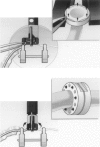Superficial temporal artery to middle cerebral artery bypass
- PMID: 16148974
- PMCID: PMC1150876
- DOI: 10.1055/s-2005-870599
Superficial temporal artery to middle cerebral artery bypass
Abstract
The superficial temporal artery to middle artery bypass is a technique that allows the blood supply from the extracranial carotid circulation to be routed to the distal middle cerebral artery branches. The procedure allows blood flow to bypass proximal lesions of the intracranial vasculature. The performance of this bypass requires specialized microvascular training and the use of microvascular techniques. The techniques involved in performing these procedures include microdissection of the superficial temporal artery in the scalp, microdissection of the recipient middle cerebral artery branches near the sylvian fissure, and anastomosis techniques using either microvascular sutures or a microanastomotic device. The successful completion of the bypass and subsequent patency requires meticulous attention to technical details.
Figures












References
-
- Yasargil M G. A legacy of microneurosurgery: memoirs, lessons, and axioms. Neurosurgery. 1999;45:1025–1092. - PubMed
-
- Weerd A W de, Veldhuizen R J, Veering M M, Poortvliet D C, Jonkman E J. Long-term clinical and neurophysiological effects of reconstructive vascular surgery for cerebral ischemia. Acta Neurol Scand. 1989;79:311–315. - PubMed
-
- Diaz F G, Umansky F, Mehta B, et al. Cerebral revascularization to a main limb of the middle cerebral artery in the Sylvian fissure. An alternative approach to conventional anastomosis. J Neurosurg. 1985;63:21–29. - PubMed
-
- Gratzl O, Schmiedek P. STA-MCA bypass: results 10 years postoperatively. Neurol Res. 1983;5:11–18. - PubMed
-
- Spetzler R F. Retinal circulation after STA-MCA bypass. Neurosurgery. 1985;16:583. - PubMed

